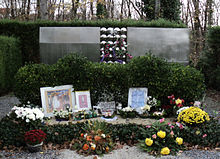Jastrebarsko children's camp
The camp was located in the town of Jastrebarsko, about 37 kilometres (23 mi) southwest of the NDH capital, Zagreb, and operated from 12 July until October 1942.
Camp administration was provided by nuns of the Daughters of Charity of Saint Vincent de Paul order, with Ustaše guards.
While the invasion was still underway, the Germans orchestrated the proclamation of the Independent State of Croatia (Croatian: Nezavisna Država Hrvatska, NDH) by the fascist and Croat-chauvinist Ustaše party.
The government of this Italo-German quasi-protectorate immediately implemented a "savage policy aimed at fashioning a largely homogeneous state out of a heterogeneous population".
[1][2] According to the historian and political scientist Sabrina P. Ramet, the NDH was run by the most brutal and bloody puppet regime in Axis-dominated Europe during World War II,[1] which incited widespread massacres and operated concentration camps targeting Serbs, Jews, Romani people and other "undesirables".
[1][3] In particular, the Ustaše regime expelled large numbers of Serbs from the NDH,[4] and was involved in widespread mass murder,[5] resulting in Ramet's conclusion that it was genocidal in both intent and in practical terms.
[11] Children had also been taken during anti-Partisan operations conducted by German, NDH and other collaborationist forces between April 1941 and June 1942, such as the Kozara Offensive.
Those children who had not been killed in the massacres and counter-insurgency operations were rounded up, as their villages had in most cases been burned to the ground, and they had no means of support.
Information about the plight of these children was passed to concerned citizens in the NDH capital, Zagreb, one of whom was Diana Budisavljević, an Austrian.
Budisavljević approached an Ustaše-appointed member of the board of the Croatian Red Cross, Kamilo Brössler, and told him about the children at Stara Gradiška.
Brössler was horrified, and with the support of representatives of the International Committee of the Red Cross, began to place pressure on the NDH government to release the children.
[12] The NDH government struck upon the idea of trying to re-educate the children to become something akin to an Ustaše version of the Hitler Youth, thereby turning them against their Serb parents.
This location was chosen due to its close proximity to Zagreb, which reduced exposure to Partisan influence and made defence easier.
The buildings earmarked to accommodate the children were: the castle Dvorac Erdödy, the nearby Franciscan monastery, and the former Italian barracks and stables.
[23] In early July 1942, 16 Red Cross nurses were sent from Zagreb to the Stara Gradiška concentration camp to collect 650 children and bring them to Jastrebarsko.
[22] According to the historian Dragoje Lukić, a total of 3,336 children passed through the camp during its existence, aged between one and fourteen years old.
[28] Another survivor, Radomir Krnjajić, recalled that they were fed a variety of foods, including pumpkin soup, cucumbers, beets and similar vegetables, and sometimes received a little macaroni or beans, but very little bread.
[29] Gojko Knežević, another camp survivor, recounted many years later that the nuns beat the children with birch branches dipped in salt water or vinegar.
[30] The author and former military judge Ivan Fumić concludes that the children were systematically punished for various infractions, and were treated harshly by the Ustaše and the majority of the nuns.
[31] In response to the parlous conditions and poor state of the children's health, the Croatian Red Cross and some locals from Jastrebarsko and Donja Reka,[15] led by Tatjana Marinić [sh], a local teacher, Communist and social worker,[32] collected food and distributed it among the children, decorated the walls, and treated their illnesses.
It took some time for the helpers to earn the trust of the children due to the latter's harsh treatment at the hands of the Ustaše, but gradually their health began to improve.
More importantly, from the end of July, twenty-six volunteer nurses from the teachers' school at Rude near Samobor, along with several doctors and other medical personnel, under the leadership of Marinić, began to intervene with the camp administration and Ustaše guards to improve the health of the children.
[41] Lukić states that the Partisans rested the remaining children at Žumberak for a day, before arranging for them to be transferred across the Kupa river into liberated areas of the Bosanska Krajina.
[39] According to one survivor, Mihajlo Veljić, some of the children who were liberated from the camp by the Partisans in August 1942 were placed with families in the Žumberak district and were subsequently re-captured by the Ustaše.
[13] On 15 October 1944, Marinić filed charges against Pulherija and Gaudencija before the Croatian State Commission for the Determination of Crimes by the Occupiers and Their Supporters.
[43] According to Fumić, the inhumane actions of Pulherija and other nuns and their role in the deaths of many children has never been addressed, much less condemned, by the Catholic Church.
[45] In response, the Roman Catholic Archdiocese of Zagreb sent a letter to Patriarch Porfirije protesting the canonization, stating that "with regard to this matter, the Holy Synod of Bishops of the Serbian Orthodox Church has obviously accepted rhetoric and communist propaganda, full of untruths and manipulations, with which it is being attempted to blame innocent people for the alleged torture and murder of children, thousands of whom, owing to the love and care of Croatian Catholics, were saved from death and survived the difficult wartime conditions.



